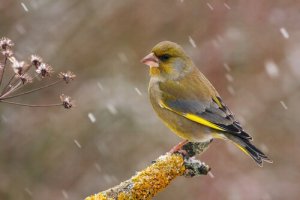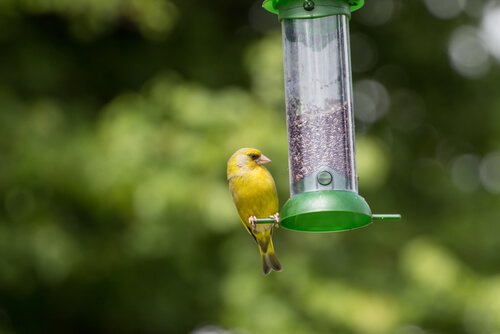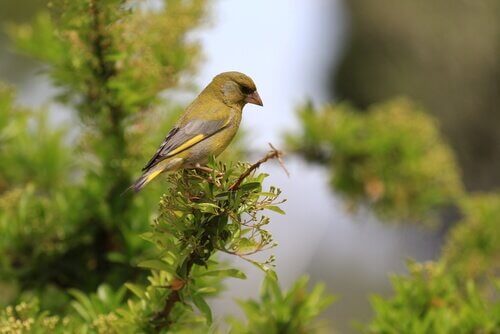The European Greenfinch: Characteristics, Behavior and Habitat


Written and verified by the vet Eugenio Fernández Suárez
The European greenfinch is one of the most common species of small birds both in Europe and on the Iberian Peninsula. The characteristics of this small finch aren’t widely known, even though it is one of the most commonly seen birds in your garden.
The finches are a group of passerines. These account for around half of the birds we know best. Finches have a characteristic strong conical beak and are forest birds. They also have a characteristic undulating way of flying.

European greenfinch characteristics
The European greenfinch (Chloris chloris) is a small bird about 15 centimeters long. It gets its name from the greenish color of its characteristic plumage. Males are particularly striking as they have a strong green color in their plumage and yellow spots on their wings and tails.
In the case of the female, the color is much fainter. It is mainly brown with yellow markings on the wings and tail, and much paler in tone than the males of this species. This sexual dimorphism is prevalent in many birds, and it’s vital to understand the courtship of these birds, so common in our latitudes.
The greenfinch is very common throughout Europe. And it’s one of the invasive exotic species present in Argentina, Uruguay, Australia and New Zealand too. Its three subspecies are distributed throughout much of Europe and western Asia.

Greenfinch behavior
This bird has a characteristic tweet and mimics the sounds of other birds. Thanks to its powerful, typical beak, the finches can crack hard seeds of cereals, ash, or pine nuts. In addition to this, it also feeds on rose hips or brambles.
Its diet also includes invertebrate bugs such as beetles, ants, and spiders. On occasions, the European greenfinch consumes fruit tree buds, although it seldom eats ripe fruit. The only time it does is in Autumn, so as not to disturb crops.
Male greenfinches begin their courtship around March. It consists of small jumps with which they suspend themselves in the air and flutter while chirping in their characteristic manner.
Greenfinch usually nest in groups. Only females participate in nesting, and at the end of the breeding season they gather in large flocks and join other groups of migratory birds.
Greenfinch habitat
These birds breed in forests, gardens, and orchards, and tend to prefer rows of trees, cypress in particular. It isn’t rare for greenfinches to hang out in cemeteries.
In general, the habitat of a greenfinch consists of areas of scattered vegetation and pine forests. Normally finches normally inhabit growing areas, so it’s not uncommon to see them in orchards, or fields of wheat and other cereals.
Although this bird is not in danger of extinction, illegal poaching of wild animals is a threat to them. In Spain, for example, greenfinches are often captured for their beautiful song. This activity is not a serious problem for the conservation of these species, but it does compromise their well-being.
The European greenfinch is one of the most common species of small birds both in Europe and on the Iberian Peninsula. The characteristics of this small finch aren’t widely known, even though it is one of the most commonly seen birds in your garden.
The finches are a group of passerines. These account for around half of the birds we know best. Finches have a characteristic strong conical beak and are forest birds. They also have a characteristic undulating way of flying.

European greenfinch characteristics
The European greenfinch (Chloris chloris) is a small bird about 15 centimeters long. It gets its name from the greenish color of its characteristic plumage. Males are particularly striking as they have a strong green color in their plumage and yellow spots on their wings and tails.
In the case of the female, the color is much fainter. It is mainly brown with yellow markings on the wings and tail, and much paler in tone than the males of this species. This sexual dimorphism is prevalent in many birds, and it’s vital to understand the courtship of these birds, so common in our latitudes.
The greenfinch is very common throughout Europe. And it’s one of the invasive exotic species present in Argentina, Uruguay, Australia and New Zealand too. Its three subspecies are distributed throughout much of Europe and western Asia.

Greenfinch behavior
This bird has a characteristic tweet and mimics the sounds of other birds. Thanks to its powerful, typical beak, the finches can crack hard seeds of cereals, ash, or pine nuts. In addition to this, it also feeds on rose hips or brambles.
Its diet also includes invertebrate bugs such as beetles, ants, and spiders. On occasions, the European greenfinch consumes fruit tree buds, although it seldom eats ripe fruit. The only time it does is in Autumn, so as not to disturb crops.
Male greenfinches begin their courtship around March. It consists of small jumps with which they suspend themselves in the air and flutter while chirping in their characteristic manner.
Greenfinch usually nest in groups. Only females participate in nesting, and at the end of the breeding season they gather in large flocks and join other groups of migratory birds.
Greenfinch habitat
These birds breed in forests, gardens, and orchards, and tend to prefer rows of trees, cypress in particular. It isn’t rare for greenfinches to hang out in cemeteries.
In general, the habitat of a greenfinch consists of areas of scattered vegetation and pine forests. Normally finches normally inhabit growing areas, so it’s not uncommon to see them in orchards, or fields of wheat and other cereals.
Although this bird is not in danger of extinction, illegal poaching of wild animals is a threat to them. In Spain, for example, greenfinches are often captured for their beautiful song. This activity is not a serious problem for the conservation of these species, but it does compromise their well-being.
This text is provided for informational purposes only and does not replace consultation with a professional. If in doubt, consult your specialist.








